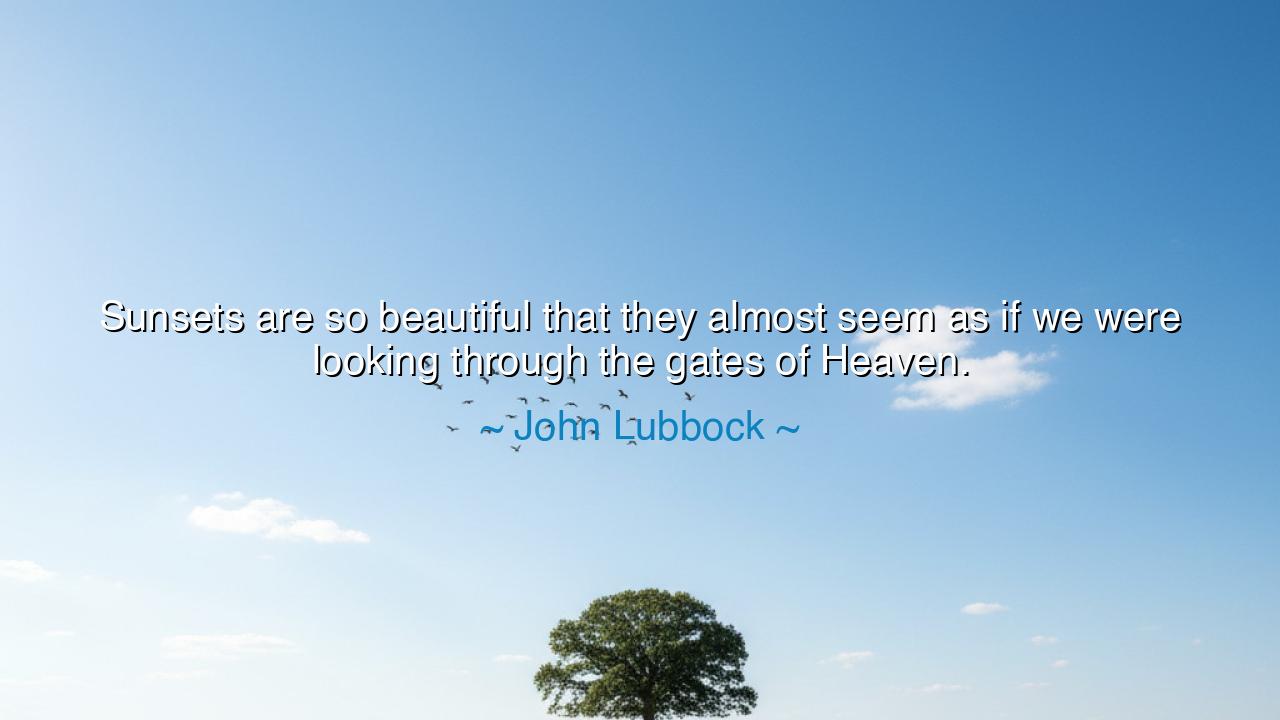
Sunsets are so beautiful that they almost seem as if we were
Sunsets are so beautiful that they almost seem as if we were looking through the gates of Heaven.






John Lubbock once wrote: “Sunsets are so beautiful that they almost seem as if we were looking through the gates of Heaven.” In these words we find a hymn to the eternal union of earth and sky, a reminder that in the fleeting moments of day’s end, we glimpse something far beyond ourselves. The sunset is not merely the dying of light, but a vision of glory—a threshold, a gateway, a promise that beauty is not confined to this mortal realm but points toward the eternal.
Lubbock, a man of science, naturalist, and philosopher, was no idle dreamer. He studied the world with the rigor of reason, yet even he could not deny the sacred awe inspired by the falling of the sun. To him, the sunset was proof that nature itself is a temple, where the heavens lean down to touch the soul. His words remind us that science and wonder are not enemies: the careful observer may see the mechanics of the sky, yet still kneel before its majesty.
The ancients also saw the heavens as a mirror of the divine. To the Egyptians, the setting sun was the god Ra entering the underworld, to rise again in triumph at dawn. To the Greeks, Helios guided his chariot of fire to the edge of the earth, where sky meets sea. And to poets across centuries, the sunset has always been a symbol of transition—not of ending, but of passage, like a door through which one steps into mystery. Lubbock’s “gates of Heaven” echo this timeless vision, where the colors of twilight seem to open a path into eternity.
History offers us moving moments where men, confronted with sunsets, found strength and solace. It is said that during the long march of Napoleon’s soldiers across the frozen fields of Russia, many paused at twilight to look upon the burning horizon, and for a moment forgot hunger and death, comforted by beauty that even war could not destroy. In that daily miracle, the weary soul found a glimpse of immortality, a reminder that beyond human struggle, there lies something higher and more enduring.
The lesson of the sunset is thus twofold. First, it teaches humility: for no human hand can paint such a sky, no empire can command such radiance. Second, it teaches hope: for even the day, when it dies, dies in beauty, as if whispering that endings are but beginnings in disguise. If the sun itself sets in splendor, then perhaps our own passages, our own farewells, may also lead to light beyond the horizon.
Practically, let each person take time to behold the sunset. Do not hurry past it, as though it were a trivial event, but pause and let its colors write their lesson upon your heart. In moments of sorrow, let the twilight remind you that beauty endures even in endings. In moments of pride, let it humble you, showing that the universe holds glory beyond all human achievement. In moments of uncertainty, let it comfort you, as though you were indeed peering through the “gates of Heaven.”
Thus, Lubbock’s words call us to awaken wonder in the midst of daily life. The sunset, ever ancient and ever new, is the daily gift of heaven to earth, the reminder that beauty is not rare but constant, and that beyond all toil and striving, a greater light awaits. To honor the sunset is to honor the eternal truth: that the world, in all its fleeting hours, is touched with the hand of the divine.






AAdministratorAdministrator
Welcome, honored guests. Please leave a comment, we will respond soon